Growing up on Long Island (Bethpage), NY – I felt lost in my late teens. Worried about my future direction in life, my father gave me an old Argus rangefinder to fool around with. Little did he realize what an important gesture that would turn out to be for me. After doing some research and seeing the images of Minor White and Ansel Adams I quickly became addicted to photography. To make a long story short, I left home at 21, quitting my job, leaving my friends and family to see the American Southwest for myself. In California I eventually met my wife, and together we had 3 children, and created our own design studio - and the tasks of running a business and raising a family took a priority to Photography. During that time I stopped taking pictures. Years later, in early 2005, inspired by my wife, children and friends - I again picked up my cameras. Today I see myself on a passionate mission to make up for years of lost time - creating images that help evoke how I see our wonderful planet. I feel that I owe much to the great photographers of the past, especially Ansel Adams, for their dedication to the craft and for inspiring me in my late teens. Though I have never met them, their inspiration helped me determine the course my life would take.
Source: www.mitchdobrowner.com
Represented by:Photo-Eye Gallery, Santa Fe NM
Iris Gallery, Boston MA
GADCOLLECTION, Paris France
Catherine Couturier Gallery, Houston TX
Kopeikin Gallery, Los Angeles, CA
Wall Space Gallery, Santa Barbara, CA
